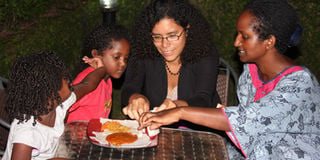A taste of Abyssinian in Uganda

Negede Akolwode (R) enjoys a meal of enjera and shiro with her daughters and a friend. PHOTOS BY ABUBAKER LUBOWA
What you need to know:
work and most came to seek refuge. Irrespective of their reasons, the Ethiopian Eritrean communities have found a way to bring a piece of their homeland to Uganda.
The first sign of Ethiopian culture in Uganda would be the Ethiopian restaurants sprinkled across the city’s suburbs. Kabalagala and Kansanga probably have most of them, from the well-known Ethiopian Village Restaurant to obscure ones like Dukem Restaurant. But other estates have them too, Nakulabye, Mengo, even Kololo has one, the enjera Gezana also known as Casablanca located on Acacia avenue.
The locations may be as different as the type of restaurant, for example, the upmarket location and status of enjera Gezana cannot be compared to the rustic kafundaish charm of Abinet Restaurant in Kabalagala. But they all serve the same, or pretty similar fare. Eri-Ethio food/Abyssinian cuisine or Habesha food, which is basically delicacies from Ethiopia and Eritrea. While the country may be many miles away, inside these restaurants one is able to get a piece of Ethiopia, from the décor to the food, to some of the art work that is almost always invariably displayed on the walls.
Security in numbers
The restaurants act as beacons if you are trying to find where the Ethiopian community tends to live in the sprawling mass of housing that is Kampala. According to an Eritrean I spoke to, Philo Tekei, Habesha people,( Eritreans and Ethiopians) tend to live in Nakulabye, Old Kampala, Mengo, Najjanankumbi, Kabalagala and Kansanga. “Those are not the only places they live, but they are many in those places,” he says.
Tekei who works at the Enjera Gezana may not have a reason as to why members of the community prefer these areas to all the suburbs in the city, though I have a theory that it has to do with wanting to stay close to what is familiar.
Here is how that works. The first Ethiopians came and settled around these areas and soon set up business, say an Ethiopian restaurant, when the others just arrive in the country, they seek out their fellow countrymen and end up living close by if for nothing, to at least, feel as close to home as possible in a new country. None of the Ethiopians I speak to confirm this though Tekei says a non-committal “maybe” when I pitch it to him. Bringing a culture as rich as the Ethiopian or Eritrean culture with you to another country cannot be as easy. But from the looks of it, the Ethiopians do try. From shops that sell cultural items like traditional wear, coffee ceremony paraphernalia, to food items.
Others try and bring little pieces of home, like Eskedar Aderajew, an Ethiopian living in Uganda who invites us to her house for an evening gathering with her friends. She came to work at the African Initiative for Relief and Development and has been here for a year. She says she finds Kampala interesting in different ways. She is amazed at how there is a thriving Ethiopian community here. “Everything you have in Addis, you find here,” she tells her friends.
Taking pride in dressing
Aderajews house is furnished like a lot of other Ugandan houses, except for the circular woven mats hanging on the wall. “This is a traditional winnowing basket from Ethiopia. I brought it with me and use It as a post-it noticeboard,” she says. She also has some of the Ethiopian traditional dresses, which she saves for ceremonies and church service. Aderajew graciously offers me to try a flared dress, which I had found out at Kansanga goes for between Shs280,000 and Shs350,000 together with its shawl. While we happily pose for pictures sans shawl, I later learn that if you are going to the Coptic Orthodox Church, then the shawl is not optional.
Majority of Ethiopians and Eritreans subscribe to the Coptic Orthodox Church. A few have gone evangelical though and there is a church that stands as testament to that in Nsambya, right next to Sharing Hall. “You must cover your head when going to church,” says Aderajew.
You can see the Ethiopian ladies in their white Neteala (this is what Tekei tells me the white shawl is called) hurrying to the Orthodox Church in Bunga Soya on Sunday morning and again in the afternoon as they head back home. A few, the more mature looking ones may be in the gathered long dresses too, but many others make do with jeans and regular pants and throw on the long shawl over their outfits.
Seeing all the ladies’ clothes, I am forced to ask if there is a traditional garb for men. Ammanuel, one of Aderajews friends who is here for a short assignment, says the men’s traditional outfit is often an all-white ensemble, comprising of a tunic and pants with a patterned panel down the front. Sometimes it is worn with a scarf.
Music has been one of the easier things to transport. Negede Akolwode, an Ethiopian living in Uganda, tells me she brought her own music from Ethiopia. It is a distinct sound, this music, a sort of jerky drumbeat that threatens to make even the stiffest of shoulders move. You hear strains of it in the various internet cafes run by Ethiopians and Eritreans, in the restaurants and if you happen to have an Eritrean neighbour.
Tekei tells me that it is only here that one can point out a real difference between Ethiopian and Eritrean cultures. The music, and not necessarily in the choice of instruments or arrangement, but in the language. Eritrean music will invariably be in Tigrinya while Ethiopian music is in Amharic. The two are the widely spoken languages in those countries respectively.
Where cuisine is a ceremony
Eri-Ethio cuisine is a whole new world. At Aderajew’s home, we get to sample some of the foods that make up Ethiopian food. The Ethiopian staple in enjera. It is a sort of flat bread with specially made stews. Enjera back in Ethiopia, is prepared with flour from teff, a grain that grows only in that region. But teff being hard to come by in Uganda, the alternative is Enjera made from a mixture of wheat and rice flour. “The teff Enjera is brown and has a sour taste while the wheat and rice flour Enjera has a milder taste,” says Akolwode, who painstakingly takes me through the process of preparing enjera. The long and short of it is she uses a specially made kiln, a pan like contraption, and the enjera dough has to be mixed with yeast and left to mature.
The enjera cooker is made of clay and has to be brought in from Ethiopia and is the only place that enjera can be prepared. Ruta, an Eritrean also living in Uganda, tells me that it is possible to purchase readymade enjera at various Ethiopian shops around Kampala, if one is unable to prepare it at home. The bit about yeast explains what I can call the characteristic taste of enjera, a tangy sort of sour bite that is hard to compare with anything. The stew is served atop the enjera and so, one has to employ method when enjoying an enjera dish, working your way from the outside to center and using the Enjera to scoop the sauce.
From what I gather, Ethiopian-Eritrean cuisine is not for the impatient, as preparing something as simple as chicken stew (dorowat) is a whole ceremony. “You need four hours to get it ready,” says Negede. She also lets me know that back in home country not only does a woman make dorowot, but dorowot makes the woman. Knowing how to properly prepare dorowot is the mark of a complete woman. It is also the must prepare meal for a distinguished guest, and celebrations.
Apparently, the difference between your regular chicken sauce and dorowot is the washing, and precooking preparations that includes rubbing with several special spices. Some of the spices have to be shipped in from Ethiopia or Eritrea like the berbere powder that is a mix of chili and a zillion other spices and that features almost in every meal. “We do not add it in vegetables, beans and peas or children’s meals,” says the soft spoken Negede.
The other direct import is shiro, a ground mix of peas and beans that is cooked as sauce. While some people may make it at home, the bulk is brought in from Ethiopia. Shiro is one of the foods that Ethiopians and Eritreans who are Coptic Orthodox faithful can still eat during this Lenten period.
The Ethiopian calendar has 13 months and is seven years behind the Gregorian calendar, which we use. The events like Christmas and Easter are always after the rest of the world celebrates. Easter for example, is just coming up at the start of next month, as the lent season ends on May 5. Those fasting during lent are encouraged to keep a diet free from animal products. No dairy products, no eggs, no meat in any form,” shares Aderajew
Coffee, a cherished beverage
It is no secret coffee takes centreplace in this culture. It is believed to have been first consumed there after all. But the ceremony around coffee drinking still piques one’s curiosity. There is nothing like just pouring and knocking back your cup. Coffee with friends is a ceremony that involves preparing it right from scratch.
It means roasting the green beans right in front of everyone, crushing the coffee in a mortar, brewing it and serving in miniscule cups, accompanied by sweet treats like biscuits or chocolate. Some Ethiopians have been able to keep this up, holding little coffee parties and doing it as close to the old way as possible. Some Ethiopian restaurants even serve the coffee still steaming atop little clay kiln. But sometimes, you do not have everything that is required to make the coffee ceremony.
At Aderajew’s house, we had coffee, roasted on a hot plate, but they were Ethiopian coffee beans and the pan was a special one for roasting coffee beans and even if the coffee could not be prepared in everyone’s full view, it was brought out for everyone to sniff. And when it came to tasting, it was still richer and more aromatic than any cup of coffee I have taken before.
One of the delicacies we do not get to sample but cannot stop talking about is the raw meat dish called Kitfo. It is delicious, you spice it and serve it, shares my host Aderajew. With her fellow countrymen, they convince me that this dish is one to sample like they did Nsenene.
Home being the best place Ethiopians and Eritreans seem determined to take as much of it with them as possible. “We get Ethiopian television ETV by hook or crook,” says Akolwode when I ask how she stays entertained here. There is also the gathering with friends and fellow Ethiopians which takes the home sickness down a notch.
Two countries, similar cultures
I set out to write two different pieces on Ethiopians and Eritrean culture convinced that they were two distinct cultures seeing as they have a border between them. This is why I found Philo Tekei my guide on Eritrean culture’s response on what made their culture different from Ethiopians.
“It is the same,” he said. He pointed out several websites that would confirm that most of the aspects of culture I was looking to explore, the food, the clothes. At least in the case of food the dishes seem to cut across both countries, with enjera being the staple. The restaurants around sometimes announce Eri- Ethio cuisine as opposed to just saying Ethiopian or Eritrean food. I did could not find a difference in the outfits either. Still I was convinced there must be some differences.
“The music is different,” says Tekei. I have a hard time noticing this basically because it does have the same beat but he lets me know where the difference is in the language. Ethiopian music tends to be in Amharic while that from Eritrea is in Tigrinya.
Amsalu Tizazu Meta, a counselor at the Ethiopian Embassy in Kitante says the culture are more or less similar. You know Ethiopia and Eritrea was one country before. Tizazu refers to Eritrea being a part of Ethiopia until 1993 when a Eritreans overwhelmingly voted to be independent in a referendum. Despite the frosty relations between the governments of the two countries which has resulted into full out border conflicts, Ethiopians and Eritreans seem to live in harmony in Kampala. At Kansanga I join a group of Ethiopian and Eritrean youth in a game of pool and one Lij Alem does not hesitate to tell me that despite the animosity between the governments they are the same people. “Here we are brothers,” says one Lij Alem he said hugging another youth who I presume is from Eritrea.
Tizazu notes Ethiopian culture may also include more varied cultures due to it’s over 80 tribes, way more than are found in Eritrea. What we see then is a small part of it, one unique to Habesha which is a term that refers to members of some ethnic people spread over Ethiopia and Eritrea.




